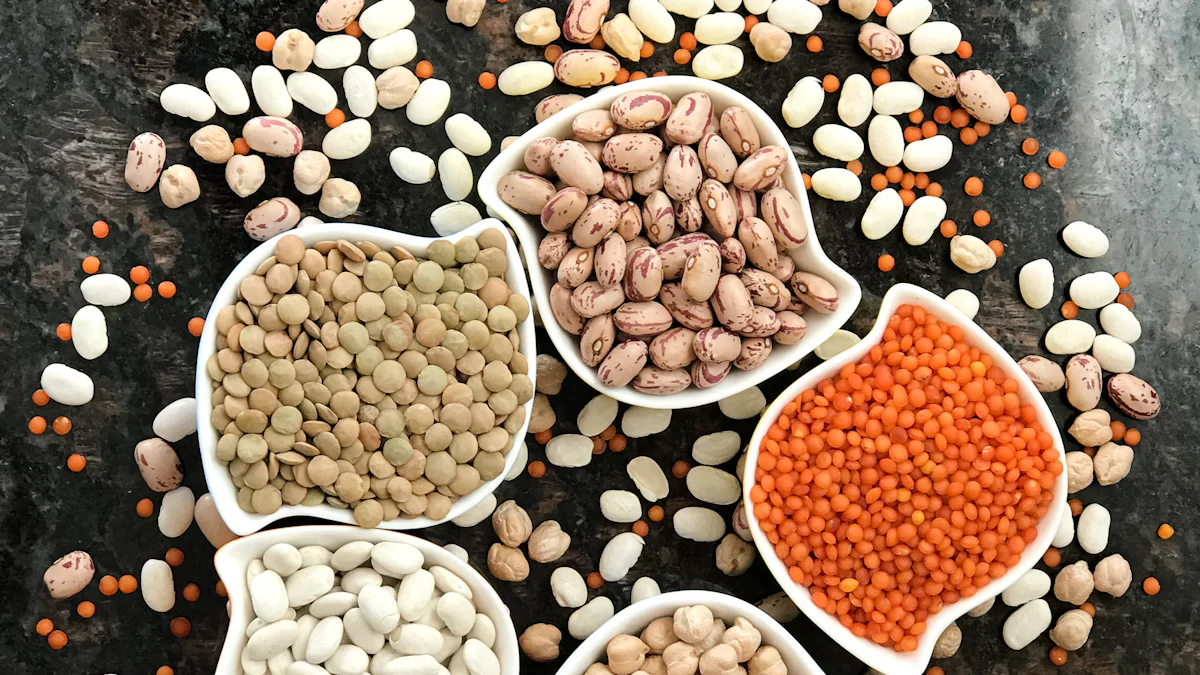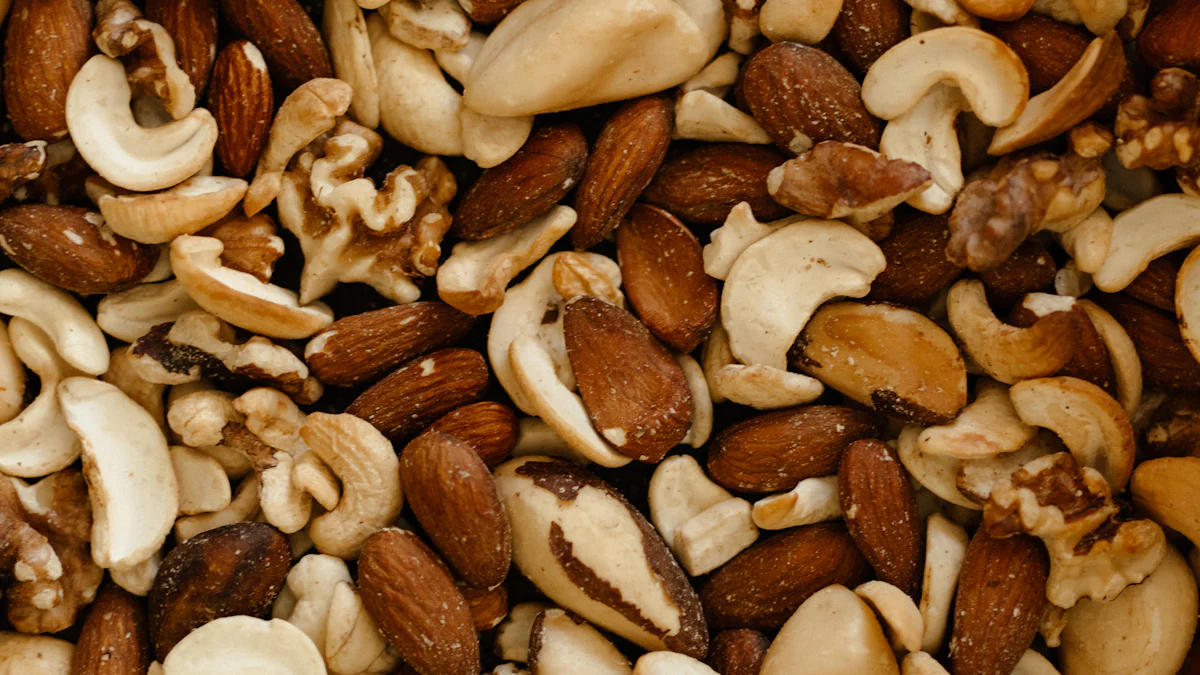Protein plays a crucial role in immune function, tissue repair, and muscle growth. Americans consume 65 to 90 grams of protein each day. Common protein sources include meat, dairy, and eggs. However, many hidden protein sources exist that can diversify and balance diets. These surprising sources can help avoid excess consumption of animal products while meeting nutritional needs.
Surprising Sources in Legumes and Pulses

Lentils
Nutritional Content
Lentils offer a rich source of protein, providing about 16.7 grams per cup of cooked lentils. These legumes also contain essential nutrients such as iron, folate, and fiber. Low phytic acid lentils may increase micronutrient bioavailability, making them even more beneficial.
Health Benefits
Lentils can improve diet quality by offering a high-protein, low-fat option. These legumes support heart health due to their fiber content. The iron in lentils helps prevent anemia, while folate supports cell function and tissue growth. Consuming lentils can aid in weight management because they promote a feeling of fullness.
Usage Suggestions
Lentils can be added to soups, stews, and salads. Cooked lentils make a great base for veggie burgers. Incorporate lentils into casseroles or use them as a meat substitute in tacos. These versatile legumes can also be pureed into dips or spreads.
Chickpeas
Nutritional Content
Chickpeas, also known as garbanzo beans, provide around 14.5 grams of protein per cup of cooked chickpeas. These legumes are packed with dietary fiber, vitamins, and minerals. Chickpeas contain significant amounts of folate, iron, and magnesium.
Health Benefits
Chickpeas contribute to heart health by lowering cholesterol levels. The fiber in chickpeas aids in digestion and helps maintain a healthy gut. Iron in chickpeas supports oxygen transport in the body, while magnesium promotes muscle and nerve function. Regular consumption of chickpeas can improve overall diet quality.
Usage Suggestions
Chickpeas can be roasted for a crunchy snack. Add chickpeas to salads, soups, and stews for extra protein. Blend chickpeas into hummus or other dips. Use chickpeas in curries or as a base for veggie patties. These legumes can also be mashed and used as a filling for sandwiches or wraps.
Chia Seeds
Nutritional Content
Chia seeds pack a punch with 4 grams of protein per ounce. These tiny seeds also contain high levels of omega-3 fatty acids, fiber, and antioxidants. Chia seeds provide essential minerals such as calcium, magnesium, and phosphorus.
Health Benefits
Chia seeds can support heart health due to their omega-3 fatty acid content. The fiber in chia seeds aids digestion and promotes a feeling of fullness, which can help with weight management. Antioxidants in chia seeds protect cells from damage and reduce inflammation.
Usage Suggestions
Chia seeds can be sprinkled on yogurt, oatmeal, or salads. Mix chia seeds into smoothies for an extra protein boost. Chia seeds can also be used to make chia pudding by soaking them in milk or a milk alternative. Add chia seeds to baked goods like muffins or bread for added nutrition.
Hemp Seeds
Nutritional Content
Hemp seeds offer a rich source of protein, providing about 10 grams per ounce. These seeds are high in healthy fats, including omega-3 and omega-6 fatty acids. Hemp seeds contain significant amounts of manganese, copper, magnesium, and phosphorus.
Health Benefits
Hemp seeds can boost heart health due to their healthy fat content. The protein in hemp seeds supports muscle growth and repair. Hemp seeds may reduce inflammation and improve skin conditions. The fiber in hemp seeds aids digestion and promotes gut health.
Usage Suggestions
Hemp seeds can be sprinkled on salads, cereal, or yogurt. Blend hemp seeds into smoothies for a creamy texture and added protein. Use hemp seeds in baking recipes like cookies or energy bars. Hemp seeds can also be mixed into dips or spreads for a nutritional boost.
Surprising Sources in Grains
Photo by Nick Bratanek on Unsplash
Quinoa
Nutritional Content
Quinoa offers a rich source of protein, providing about 6.5 grams per cup of cooked quinoa. This grain contains all nine essential amino acids, making it a complete protein. Quinoa also provides significant amounts of fiber, iron, magnesium, and manganese.
Health Benefits
Quinoa supports muscle growth and repair due to its complete protein profile. The fiber in quinoa aids digestion and promotes a feeling of fullness, which can help with weight management. Iron in quinoa helps prevent anemia, while magnesium supports muscle and nerve function. Consuming quinoa can improve overall diet quality.
Usage Suggestions
Quinoa can be used as a base for salads or bowls. Add quinoa to soups and stews for extra protein. Cooked quinoa makes a great substitute for rice or pasta. Incorporate quinoa into breakfast dishes like porridge or pancakes. Use quinoa in baking recipes like muffins or bread for added nutrition.
Amaranth
Nutritional Content
Amaranth provides about 9 grams of protein per cup of cooked amaranth. This grain is rich in lysine, an essential amino acid often lacking in other grains. Amaranth also contains high levels of fiber, calcium, iron, and magnesium.
Health Benefits
Amaranth supports bone health due to its calcium content. The protein in amaranth aids muscle growth and repair. Fiber in amaranth promotes digestion and helps maintain a healthy gut. Iron in amaranth supports oxygen transport in the body. Regular consumption of amaranth can enhance overall diet quality.
Usage Suggestions
Amaranth can be used as a base for porridge or breakfast bowls. Add amaranth to soups and stews for extra protein. Cooked amaranth makes a great substitute for rice or couscous. Incorporate amaranth into baked goods like bread or cookies. Use amaranth in salads or as a side dish for added nutrition.
Surprising Sources in Nuts and Nut Butters

Almonds
Nutritional Content
Almonds provide a rich source of protein, offering about 6 grams per ounce. These nuts also contain significant amounts of healthy fats, fiber, and vitamin E. Magnesium and calcium are present in almonds, contributing to their nutritional profile.
Health Benefits
Almonds support heart health by maintaining optimal levels of good cholesterol. The high fiber content aids digestion and promotes a feeling of fullness. Vitamin E in almonds acts as an antioxidant, protecting cells from damage. Magnesium in almonds helps regulate blood sugar and blood pressure. Consuming almonds can reduce inflammation due to their anti-inflammatory properties.
Usage Suggestions
Almonds can be eaten raw or roasted as a snack. Add chopped almonds to salads for extra crunch and protein. Use almond flour in baking recipes like muffins or cookies. Sprinkle almonds on yogurt or oatmeal for added nutrition. Incorporate almonds into smoothies for a creamy texture and protein boost.
Peanut Butter
Nutritional Content
Peanut butter offers a high-protein option, providing about 8 grams per two tablespoons. This nut butter contains healthy fats, fiber, and essential vitamins and minerals. Folate, niacin, and magnesium are abundant in peanut butter.
Health Benefits
Peanut butter supports muscle growth and repair due to its high protein content. The healthy fats in peanut butter promote heart health. Fiber in peanut butter aids digestion and helps maintain a healthy gut. Folate in peanut butter supports cell function and tissue growth. Regular consumption of peanut butter can improve overall diet quality.
Usage Suggestions
Peanut butter can be spread on toast or crackers for a quick snack. Add peanut butter to smoothies for a protein boost. Use peanut butter as a dip for fruits like apples or bananas. Incorporate peanut butter into baking recipes like cookies or energy bars. Mix peanut butter into sauces or dressings for a creamy texture and added flavor.
Surprising Sources in Vegetables
 Photo by Meizhi Lang on Unsplash
Photo by Meizhi Lang on UnsplashSpinach
Nutritional Content
Spinach offers a robust nutritional profile. One cup of cooked spinach provides about 5 grams of protein. Spinach also contains high levels of vitamin K, vitamin A, and folate. The leafy green is rich in iron, calcium, and magnesium.
Health Benefits
Spinach supports bone health due to its high vitamin K content. The antioxidants in spinach help reduce the risk of cancer. Spinach can lower the risks of prostate and breast cancer. Iron in spinach helps prevent anemia. The fiber in spinach aids digestion and promotes a healthy gut.
Usage Suggestions
Add spinach to smoothies for a nutrient boost. Use spinach as a base for salads. Incorporate spinach into omelets or scrambled eggs. Add spinach to soups and stews for extra nutrition. Sauté spinach with garlic for a quick side dish.
Broccoli
Nutritional Content
Broccoli stands out as a nutritional powerhouse. One cup of cooked broccoli provides about 4 grams of protein. Broccoli is an excellent source of vitamin C and vitamin K. The vegetable also contains significant amounts of fiber, potassium, and folate.
Health Benefits
Broccoli supports immune function due to its high vitamin C content. The antioxidants in broccoli help reduce the risk of cancer. Broccoli contains glucosinolate and sulforaphane, which protect against cancer and decrease inflammation. The fiber in broccoli aids digestion and promotes a feeling of fullness. Potassium in broccoli helps regulate blood pressure.
Usage Suggestions
Steam broccoli for a simple side dish. Add broccoli to stir-fries for extra crunch and nutrition. Incorporate broccoli into casseroles or pasta dishes. Use broccoli as a topping for pizzas. Blend broccoli into soups for a creamy texture.
Diversifying protein sources holds significant importance for overall health. Consuming a variety of proteins can enhance diet quality and provide essential nutrients. Hidden protein sources such as legumes, seeds, grains, nuts, and vegetables offer numerous health benefits. Incorporating these foods into daily meals can support muscle growth, improve digestion, and promote heart health.
Exploring alternative protein sources can also contribute to environmental sustainability. Transitioning from resource-intensive animal proteins to lower-impact options can reduce environmental impacts. A varied and balanced diet not only supports individual health but also fosters a resilient food system.



